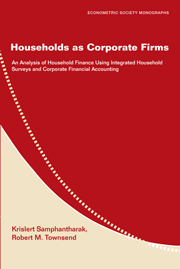 Households as Corporate Firms
Households as Corporate Firms Book contents
4 - Constructing Household Financial Statements from a Household Survey
Published online by Cambridge University Press: 05 January 2013
Summary
We discussed in chapter 2 that we can view a household as a corporate firm. We also presented the standard corporate financial accounts and argued for the advantages of creating and using the accounts for the analysis of financial situations and behaviors of the households. However, there are some characteristics that make the household and the firm different. The objectives of the studies of household and firm behavior are also not identical. Several transactions are also unique to the households in developing countries. Therefore, some modifications of the financial accounts are needed. This chapter highlights some of the important issues where special attention is needed.
As mentioned earlier, the principle contribution of this monograph is the conceptualization of the accounts. We do this in order to avoid ambiguous and mis-measured variables that would otherwise contaminate subsequent analysis. This necessitates some difficult decisions on how to deal with some unusual transactions. When we make an arbitrary decision from several possibilities, we discuss the reasons why we prefer our method as compared to possible alternatives. We use the Townsend Thai Monthly Survey discussed in chapter 3 as our illustrative survey to address these issues although the discussion in this chapter is largely applied to other household surveys in developing countries as well.
TANGIBLE ASSETS, LIABILITIES AND WEALTH
To construct a balance sheet for each household, we need information on tangible assets and liabilities.
- Type
- Chapter
- Information
- Households as Corporate FirmsAn Analysis of Household Finance Using Integrated Household Surveys and Corporate Financial Accounting, pp. 47 - 76Publisher: Cambridge University PressPrint publication year: 2009


